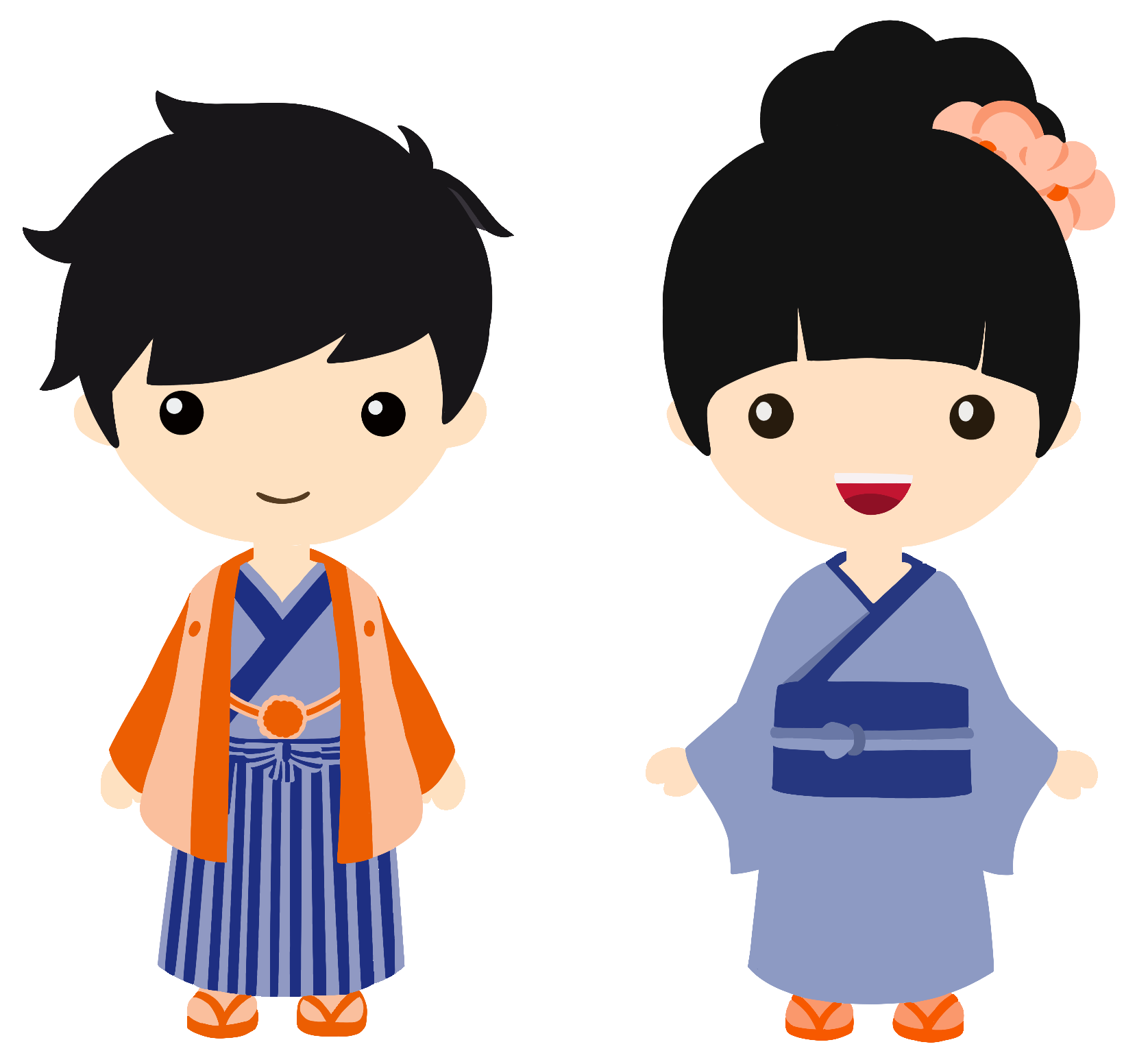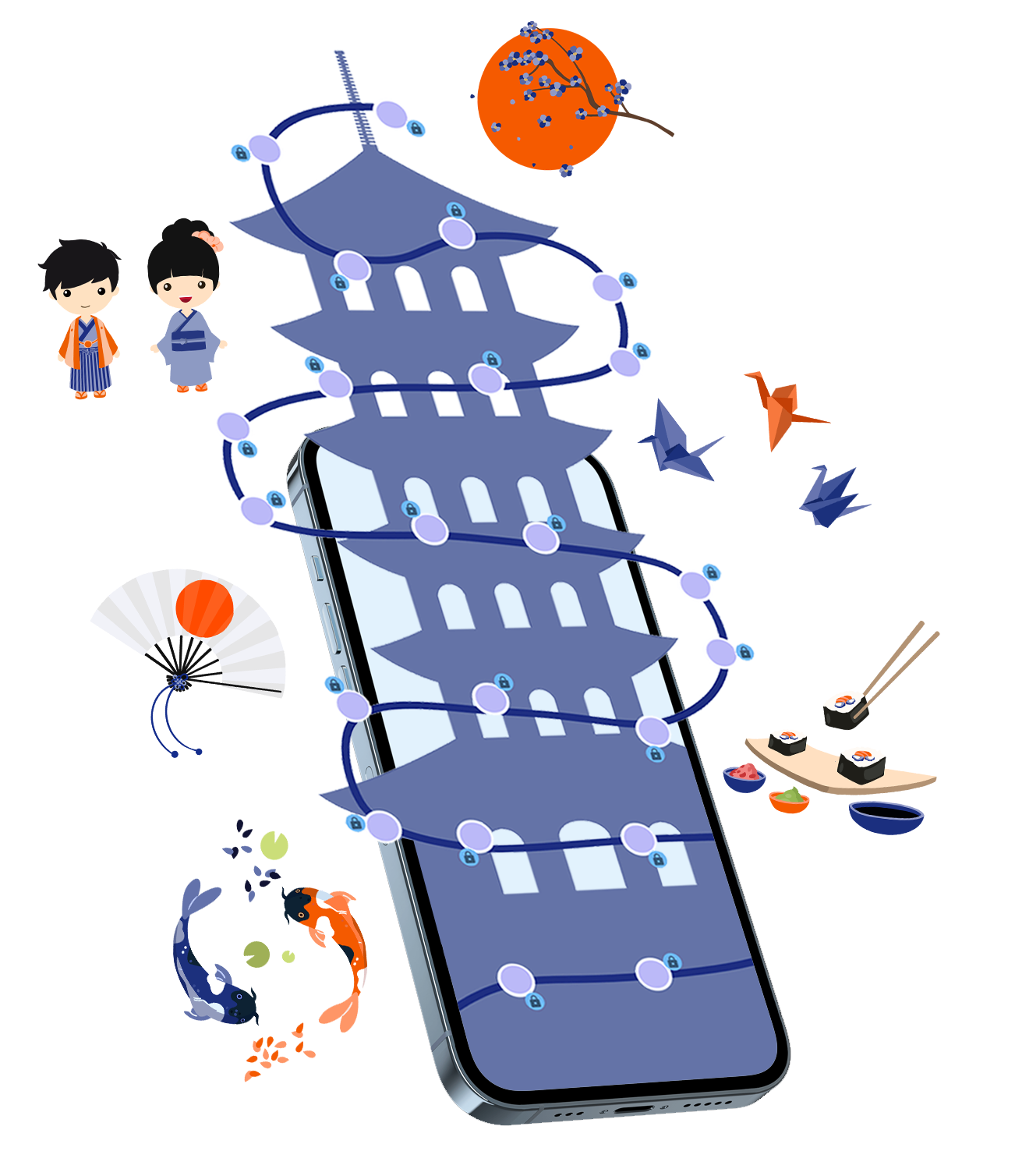
Understand the essentials of Japanese grammar in 5 minutes
 Learn now
Learn now
Summary
of the page
>
Introduction to Japanese grammar
>
The foundations of Japanese grammatical structure
>
Japanese verb forms
>
Nouns and adjectives in Japanese
>
Pronouns and polite expressions
>
Complex sentence structures
>
Pitfalls and common mistakes to avoid
>
Resources and exercises for mastering Japanese grammar
>
Summary of key points
>
Encouragement and advice to continue learning
Welcome to our exploration of Japanese grammar, an essential part of learning this fascinating language. At Globe Speaker, we know that understanding Japanese understanding Japanese grammar is essential. And we have good news. Japanese grammar, with all its idiosyncrasies, may seem daunting at first, but it's actually quite simple. but in reality it's very logical and structured. We'll explain it all below.
Introduction to Japanese grammar
The importance of grammar in learning Japanese
Why place so much emphasis on grammar, particularly in the
learning Japanese
? The answer lies in the language's unique structure. Unlike English or French, Japanese has its own unique word order and grammatical concepts.
A solid understanding of these rules is essential for constructing coherent sentences and communicating effectively. Think of grammar as a foundation:
Once you've got it right, you'll be able to build your knowledge of the language more securely and more quickly.
Overview of the unique features of Japanese grammar
Japanese grammar has several distinctive features. Firstly, the word order in Japanese generally follows the subject-object-verb model, unlike the subject-verb-object order found in many other languages.
found in many other languages.
Secondly, particles, small grammatical units, play a crucial role in indicating the function of words in a sentence. For example, the particle 「は」 (wa) is used to mark the subject,
while 「を」 (o) indicates the direct object. These nuances may seem confusing, but once mastered, they make the language extremely precise and expressive.
The foundations of Japanese grammatical structure
Let's now move on to the basics of Japanese grammatical structure, an essential cornerstone for anyone wishing to master this language. Understanding these basics is like deciphering the code of a complex but incredibly logical system.
Word order in a simple sentence
In a simple Japanese sentence, the typical word order is subject-object-verb. This is very different from the subject-verb-object order that many of us are used to. Let's take an
example: in Japanese, "I am eating an apple" would literally translate as "I am eating an apple".
This structure may seem confusing at first, but it offers remarkable clarity once you get used to it. It reflects a way of thinking that gives priority to the context and the
the object of action.
The use of particles (は, が, を, etc.)
Japanese particles, such as は (wa), が (ga), and を (o), are powerful tools for giving meaning to a sentence. Each particle has a specific function, such as indicating the subject,
object, or direction.
For example, は (wa) often indicates the subject of the conversation, while を (o) is used to mark the direct object. Mastering these particles is essential for correctly structuring
your Japanese sentences. It's fascinating to see how these little words can completely change the meaning of a sentence.
The function and form of verbs
Japanese verbs, unlike those of many European languages, are conjugated according to politeness and context, not subject. This is a unique and
captivating aspect of Japanese grammar.
The basic form of the verb, or dictionary form, is neutral. From there, it can be transformed to express respect, familiarity, negation or time. This flexibility of Japanese
is a key element in expressing not only action, but also attitude and respect towards the person you are speaking to.
Japanese verb forms
Let's delve into the world of Japanese verb forms, a complex and fascinating aspect of the language. Mastering these forms is crucial to expressing yourself correctly and the nuances of Japanese communication.
Verbs in the neutral form (dictionary form)
Verbs in the neutral form, or dictionary form, are the raw, unconjugated version of verbs. This is the form you will find when you look up a verb in a dictionary.
This form is essential to know, as it serves as the basis for conjugating verbs in all other forms. For example, the verb "to eat" in Japanese is 食べる (taberu) in its neuter form.
This is a handy starting point for learning to conjugate verbs in different contexts.
The polished form (-ます)
Let's move on to the polite form, marked by the ending -ます (masu). This form is often used in formal situations or with people you don't know well.
It adds a level of courtesy to the communication. For example, 食べる (taberu) becomes 食べます (tabemasu) in polite form. This simple but essential transformation makes it possible to navigate
various social contexts with respect and politeness.
Negative and past forms
Japanese verbs can also be conjugated to express negation or the past tense. These forms are important for precise, nuanced communication. For negation, we add ない (nai)
to the neutral form, transforming 食べる (taberu) into 食べない (tabenai), meaning "not to eat".
For the past tense, we use た (ta) for the neuter form, so 食べる (taberu) becomes 食べた (tabeta), meaning "ate". These variations are fundamental for describing actions and states in different
different temporal contexts.
Using auxiliaries to express nuances
Finally, the use of auxiliaries in Japanese allows additional nuances to be added to verbs. These auxiliaries, attached to verb forms, can express possibility, obligation or even attempt. Some examples include:
- できる (dekiru) to indicate capacity or possibility.
- なければならない (nakereba naranai) to express obligation.
- たい (tai) to express desire or envy.
Mastering these forms and auxiliaries greatly enriches your expression in Japanese, allowing you to capture subtleties and nuances in your conversations. Through these different verbal forms, you see how the Japanese language adapts and changes to reflect social context, respect and nuances of meaning.
Nouns and adjectives in Japanese
Let's now look at nouns and adjectives in Japanese, which are crucial for forming descriptive and expressive sentences. Understanding how they are classified and how they are used is essential for anyone learning Japanese.
Classification and use of nouns
Les substantifs en japonais sont relativement simples car ils ne changent pas de forme selon le nombre ou le genre. Cela simplifie grandement l'apprentissage comparé à des langues comme le français ou l'anglais.
Nouns can be names of people, places, objects, or ideas. For example, 「本」 (hon) means 'book', and this form remains unchanged whether we are talking about one book or several books.
This consistency makes Japanese nouns fairly easy for beginners to master.
Adjectives in い and な
Let's move on to adjectives, which fall mainly into two categories: い-adjectives and な-adjectives. い-adjectives, such as 「暑い」 (atsui, hot) always end in い and are conjugated to reflect time or negation. な-adjectives, such as 「静か」 (shizuka, calm), require the addition of な to link to nouns. This distinction is important for using adjectives correctly and avoiding common common mistakes in Japanese.
Modifying nouns with adjectives
Modifying a noun with an adjective in Japanese requires an understanding of the correct grammatical structure. For い-adjectives, they are placed directly in front of the noun without further modification.
For example, 「暑い日」 (atsui hi) means "hot day". For な-adjectives, we add な between the adjective and the noun. For example, 「静かな場所」 (shizukana basho) means "quiet place". These simple but essential
create precise and varied descriptions in your sentences.
Pronouns and polite expressions
Let's now explore pronouns and polite expressions in Japanese, vital aspects of communicating respectfully and understanding the social subtleties of this language.
Personal pronouns and their use
Personal pronouns in Japanese are fascinating because they often reflect gender, social status or level of formality. Unlike other languages, their use is not always necessary, as the necessary, as it is often clear from the context of the sentence who is being referred to. Nevertheless, here are some common examples:
- 「私」 (watashi): used by everyone, considered formal and neutral.
- 「僕」 (boku): often used by men, more casual.
- 「俺」 (ore): also masculine, but more colloquial.
Each pronoun can convey a different nuance of identity and relationship to the speaker, which makes their use both complex and interesting.
Levels of politeness and respect in Japanese
Japanese distinguishes between several levels of politeness, which are essential for expressing oneself correctly in various social situations. These levels influence not only the choice of words but also the conjugation of verbs. Here's an overview:
- Neutral shape Used with friends or in an informal context.
- Polished shape (-ます) : Common in everyday situations, with strangers or in a professional setting.
- Honorific and humble form Used to show greater respect, often in business circles or with people of higher rank.
These nuances of politeness are unique to Japanese and illustrate the importance attached to respect and harmony in Japanese society. Understanding and using these levels of politeness correctly is crucial to any for any interaction in Japanese.
Complex sentence structures
Let's take a look at complex sentence structures in Japanese, an area which may seem intimidating but which is essential for expressing more nuanced and detailed ideas.
The use of conjunctions and subordinates
Conjunctions and subordinate phrases are powerful tools for linking ideas and adding depth to your Japanese expressions. Conjunctions such as 「そして」 (soshite, "and then"), 「しかし」 (shikashi, "but"), and 「だから」 (dakara, "therefore") help to link sentences or clauses logically. Subordinates, introduced by particles such as 「が」 (ga) or 「けど」 (kedo, equivalents of "but" or "although"), are used to create sentences in which one part depends on the other. For example, 「雨が降るが、出かけます」 (Ame ga furu ga, dekakemasu, "It's raining, but I'm going out") shows how these elements can structure complex thought.
The construction of conditional and causal sentences
Conditional and causative sentences in Japanese are used to express hypotheses or cause-and-effect relationships. For conditionals, words like 「もし」 (moshi, 'if') followed by 「たら」 (tara) or 「なら」 (nara) are used, to form conditions. For example, 「もし時間があれば、読みます」 (Moshi jikan ga areba, yomimasu, "If I have time, I will read"). Causative constructions, on the other hand, use forms like 「させる」 (saseru) to express cause or permission. For example, 「彼に話させます」 (Kare ni hanasemasu, "I let him speak") shows how you can express one action caused by another.
Pitfalls and common mistakes to avoid
Let's discover the common pitfalls and mistakes in Japanese to help you navigate your way through the language more easily. Understanding these pitfalls can greatly speed up your progress and and boost your self-confidence.
False friends and common misunderstandings
False friends are words that sound similar to words in another language but have different meanings. In Japanese, these linguistic traps are common and can lead to misunderstandings. For example, 「勉強」 (benkyou) sounds like "bien sûr" in French, but actually means "study". Similarly, 「名前」 (namae) sounds like "name" in English, but is pronounced differently. Be careful with these words to avoid embarrassing confusion.
Tips for avoiding common grammatical errors
Here are a few practical tips to help you avoid common grammatical errors:
- Pay attention to word order : Remember that Japanese generally follows a subject-object-verb order.
- Use particles correctly : Particles such as は (wa), が (ga), and を (o) are crucial to the meaning of the sentence.
- Practise verb forms : Make sure you understand the differences between neutral, polite, negative and past forms.
- Learn the levels of politeness : Use the appropriate level of language for the person you are speaking to and the situation.
Resources and exercises for mastering Japanese grammar
To make progress in Japanese grammar, it's essential to have the right resources and to practise regularly. We have selected a range of materials and tools to help you learn effectively.
Recommended books and course materials
Here is a list of books and course materials that we highly recommend:
- Basic Japanese grammar - from theory to practice
- BUNPÔ Ippo. Japanese grammar book A1+ A2
Ces ouvrages fournissent des explications claires et sont accompagnés d'exercices pratiques pour renforcer votre compréhension. Retrouvez d’ailleurs notre guide sur les books to learn Japanese.
Application and website for practising Japanese grammar
To complete your learning, download the Globe Speaker application. Or visit our online e-learning platform. You can start learning for free and take our serious game with you and take our serious game with you to continue your learning wherever you are.
Summary of key points
To sum up, here is a list of essential points to remember when learning Japanese grammar:

In a nutshell
Understanding unique structures
Master sentence formation, from the simplest to the most complex constructions.
Importance of particles
Familiarise yourself with the use and function of particles such as は (wa), が (ga), and を (o).
Mastery of verb forms
Learn the different verb forms, including neutral, polite, negative and past tense.
Respecting levels of politeness
Master sentence formation, from the simplest to the most complex constructions.
Beware of false friends
Watch out for words that sound similar to those in other languages but have different meanings
Beware of common mistakes
Identify and avoid common mistakes to improve your command of Japanese grammar.
Encouragement and advice to continue learning
We encourage you to pursue your learning with enthusiasm and perseverance. Japanese grammar, with all its nuances and richness, opens up a fascinating to Japanese culture and thought. Use the recommended resources, practise regularly, and above all, don't be afraid to make mistakes - they're an integral part of the learning process. part of the learning process. Good luck on your exciting journey towards mastering Japanese!
Your questions
on learning Japanese
How can I learn Japanese on my own?
Is it difficult to learn Japanese?
How can I learn Japanese at home?
What's the best way to learn Japanese?
How do you say hello in Japanese?
Language Club
The blog that tells you everything about languages


Language Club
The blog that tells you everything about languages


All languages to learn
Certification preparation courses available

Toeic
They learned a new language with Globe Speaker





Très bonne organisation avec suivi de la formation.

Boumédiane • 29 ans
Niveau A2 à B2 - Abonnement Premium CPF





Rien à redire, super.

Florian • 24 ans
Niveau A1 à A2 - Abonnement Standard





Bien organisé et ludique.

Bruno • 42 ans
Niveau A2 à B1 - Abonnement Standard





Plateforme très pédagogique, et adaptée à tous les âges. J'ai vraiment eu l'impression d'apprendre.

Maria • 28 ans
Niveau A1 à B1 - Abonnement Premium





J'ai apprécié de travailler sur la plateforme Globe Speaker, autant de fois que je le voulais ou pouvais, ainsi qu'avec Maria pour la partie coaching.

Véronique • 41 ans
Niveau A2 à B2 - Abonnement Premium CPF







































